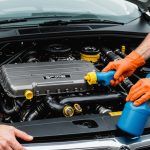Maximize Nighttime Safety: Tips to Verify Your Vehicle’s Automatic High-Beam System Functionality
Understanding the Importance of Nighttime Driving Safety
Nighttime driving can be fraught with dangers, from reduced visibility to the increased risk of accidents involving other vehicles or pedestrians. One of the key components in enhancing nighttime safety is the proper functioning of your vehicle’s headlights, particularly the automatic high-beam system. Here, we will delve into the importance of this system and provide you with practical tips to ensure it is working optimally.
The Role of Automatic High Beams
Automatic high beams are a crucial feature in modern vehicles, designed to maximize your forward visibility while minimizing glare for other drivers. This technology uses a camera sensor mounted behind the windshield to monitor the road conditions and adjust the beam settings accordingly.
Also to discover : Mastering Vehicle Stability: Tailoring Control Settings for Every Driving Condition
“Automatic high beams help you spot pedestrians, signs, and potential hazards more easily without having to manually toggle between light settings,” explains a spokesperson from Ford, highlighting the convenience and safety benefits of this feature[3].
Checking and Maintaining Your Headlights
Before diving into the specifics of the automatic high-beam system, it’s essential to ensure that your headlights are in good working condition.
Topic to read : How often should I replace my windshield wipers to maintain safe visibility?
1. Inspect Your Headlights
Make sure both headlights are functioning correctly. If one is weaker or stronger than the other, it can create uneven lighting, which can be hazardous. Check the housings and lenses for any damage or cloudiness. Cloudy or foggy headlights can significantly reduce visibility, so consider using a headlight buffering kit if necessary[1].
2. Clean Your Windshield
A clean windshield is crucial for clear visibility. Ensure that both the inside and outside of your windshield are free from dirt, dust, and other obstructions. This simple step can make a significant difference in your ability to see the road ahead at night[1].
3. Adjust Your Dash Lights
Driving with your dash lights on maximum brightness can compromise your forward vision. Dim your instrument panel and dash lights to avoid this issue and improve your nighttime driving experience[1].
Enabling and Adjusting Automatic High Beams
To get the most out of your automatic high-beam system, you need to understand how to enable and adjust it.
Steps to Enable Automatic High Beams
Here are the general steps to enable automatic high beams on your vehicle, using a Lincoln model as an example:
- Press Settings on your vehicle’s SYNC® screen.
- Choose Vehicle Settings.
- Select Lighting.
- Toggle the Auto Highbeam slider On[5].
Adjusting the System
- Ambient Light Level: The system will only activate high beams when the ambient light level is low enough to require them.
- Traffic Conditions: The system turns the high beams off if it detects an approaching vehicle’s headlamps or tail lamps, or street lighting ahead.
- Vehicle Speed: The system typically requires the vehicle to be traveling at a speed greater than approximately 52 km/h (32 mph) to activate the high beams[5].
Common Issues and Troubleshooting
While automatic high-beam systems are designed to be reliable, there can be instances where they may not function as expected.
False Activation or Deactivation
- Obstacles: The system may not switch the high beams off if the lights of oncoming vehicles are hidden by obstacles like guard rails.
- Weather Conditions: Severe weather such as fog, heavy rain, or snow can affect the system’s performance by reducing visibility[5].
Troubleshooting Tips
- Check Sensor Cleanliness: Ensure the camera sensor behind the windshield is clean and free from obstructions.
- Update Software: Sometimes, a software update may be necessary to fix any glitches in the system.
- Consult the Owner’s Manual: Refer to your vehicle’s owner’s manual for specific troubleshooting steps and guidelines.
Additional Safety Features for Nighttime Driving
Besides the automatic high-beam system, there are several other safety features and tips that can enhance your nighttime driving experience.
Night Vision Technology
Some vehicles, like the 2025 Cadillac Escalade IQ Sport, come equipped with Night Vision technology that uses thermal imaging to identify pedestrians and animals in the vehicle’s path. This feature can significantly improve safety in low-light conditions[1].
Adaptive Beam Headlights
Adaptive Beam Headlights adjust the beam pattern to reduce glare for other drivers without losing any forward lighting. This technology can increase roadway illumination by up to 86% compared to standard lights[1].
Driver-Assist Technologies
Features like Ford Co-Pilot360 and Honda Sensing® include a suite of driver-assist technologies such as Lane-Keeping Systems, Blind Spot Information Systems, and Forward Collision Warning. These features help in maintaining lane position, detecting vehicles in blind spots, and alerting the driver to potential collisions[3][4].
Practical Tips for Safe Nighttime Driving
Here are some practical tips to ensure safe nighttime driving:
Drive Defensively
Always be aware of your surroundings and drive defensively, especially at night when other drivers may be under the influence or less alert.
Avoid Drowsy Driving
Fatigue can be a significant risk factor at night. Keep yourself alert by having someone to talk to, consuming caffeine, or pulling over to rest if necessary[1].
Regular Vision Checks
Ensure your vision is not impaired by regular eye checks. Conditions like cataracts can significantly affect your ability to drive safely at night[1].
Maximizing nighttime safety involves a combination of proper vehicle maintenance, understanding and utilizing advanced safety features, and adopting safe driving practices. Here is a summary of the key points:
Key Takeaways
- Headlight Maintenance: Ensure your headlights are clean, aimed correctly, and functioning evenly.
- Enable Automatic High Beams: Follow the steps specific to your vehicle to enable this feature.
- Adjust and Troubleshoot: Adjust the system according to your needs and troubleshoot common issues.
- Additional Safety Features: Utilize other safety technologies like Night Vision and Adaptive Beam Headlights.
- Safe Driving Practices: Drive defensively, avoid drowsy driving, and get regular vision checks.
By following these tips and ensuring your vehicle’s automatic high-beam system is functioning correctly, you can significantly enhance your safety and the safety of others on the road at night.
Comparative Table of Advanced Safety Features
Here is a comparative table of some advanced safety features available in different vehicle models:
| Feature | Ford Co-Pilot360 | Honda Sensing® | Lincoln Driver-Assist |
|---|---|---|---|
| Auto High-Beam Headlamps | Automatically switches | Automatically switches | Automatically switches |
| between low and high beams | between low and high beams | between low and high beams | |
| Lane-Keeping System | Alerts and assists steering | Provides steering input | Not included |
| to keep vehicle in lane | to keep vehicle in lane | ||
| Blind Spot Information | Alerts driver of vehicles | Alerts driver of vehicles | Not included |
| in blind spot | in blind spot | ||
| Forward Collision Warning | Alerts driver of potential | Alerts driver of potential | Not included |
| collisions | collisions | ||
| Night Vision Technology | Not included | Not included | Not included |
| Adaptive Beam Headlights | Not included | Not included | Not included |
Detailed Bullet Point List for Nighttime Driving Safety
Here is a detailed list of tips to enhance your nighttime driving safety:
-
Check Your Headlights:
-
Ensure both headlights are working.
-
Clean and aim the headlights correctly.
-
Use a headlight buffering kit if necessary.
-
Use High Beams Wisely:
-
Turn off high beams within 500 feet of an approaching vehicle or when 200-300 feet behind another vehicle.
-
Use low beams when driving behind someone.
-
Keep the Windshield Clean:
-
Clean the inside and outside of the windshield.
-
Ensure no obstructions are blocking your view.
-
Dim Dash Lights:
-
Reduce the brightness of your instrument panel and dash lights.
-
Avoid Drowsy Driving:
-
Stay alert by having someone to talk to or consuming caffeine.
-
Pull over to rest if feeling fatigued.
-
Drive Defensively:
-
Be aware of other drivers who may be under the influence or less alert.
-
Anticipate potential hazards and react accordingly.
-
Get Regular Vision Checks:
-
Ensure your vision is not impaired by conditions like cataracts.
-
Avoid wearing glasses with wide frames that can restrict your vision.
By following these tips and ensuring your vehicle is equipped with the latest safety features, you can significantly reduce the risks associated with nighttime driving and make your journeys safer and more comfortable.
Understanding the Automatic High-Beam System
Automatic high-beam systems are designed to enhance nighttime safety by optimising visibility for drivers. These systems use advanced sensors and cameras to detect ambient light and the headlights of oncoming vehicles. When brighter conditions are detected, the system automatically switches from high to low beam to prevent blinding other drivers. Once the road is again clear, the high beams are reactivated. This functionality ensures that drivers have optimal visibility without compromising the safety of others.
A key benefit of using an automatic high-beam system is the enhanced safety it offers during nighttime driving. Improved visibility can reduce the risk of accidents, helping drivers detect obstacles or hazards more quickly. Additionally, not having to manually toggle the high beams allows drivers to concentrate more on the road.
These systems typically feature sophisticated technology, such as adaptive lighting and sensors capable of detecting varying levels of light intensity and vehicle distances. By integrating with existing vehicle functionalities, automatic high-beam systems provide a seamless driving experience that prioritises safety and convenience. Understanding these features can help drivers appreciate the significant role that automatic high-beam systems play in modern automotive safety.
Testing Your Automatic High-Beam System
Before hitting the road, it’s crucial to ensure your vehicle’s automatic high-beam system is functioning correctly. This can be done in a few systematic steps, each designed to help you verify functionality and ensure a seamless driving experience.
Step-by-Step Guide to Verify Automatic High-Beam Activation
- Park in a Safe Area: Start by parking your car in a secure location with low ambient light.
- Switch to Auto Mode: Turn on the headlight system and set it to automatic mode. This allows the system to adjust the beams without manual interference.
- Observe Beam Adjustments: Approach a dark road and monitor how your system responds to oncoming traffic and environmental lighting variations.
Tips for Observing and Assessing Beam Adjustments
- Stay Alert: Keep an eye on how quickly and smoothly the beams shift between high and low settings.
- Check Responsiveness: Confirm if the beams adapt promptly to changes in ambient light, ensuring no delay in response time.
Checklist for Ensuring Proper System Operation
- Sensor Cleanliness: Ensure sensors are free from dirt and obstructions.
- System Calibration: Verify calibration settings to guarantee optimal performance.
By following these steps and tips, you can confidently test your high-beam system, ensuring its reliable operation on the road.
Identifying Potential Issues
Understanding potential malfunctions in automatic high-beam systems can save time and frustration. Common problems often manifest in the form of unresponsive or erratic performance. For instance, if the high-beam fails to switch off when oncoming traffic approaches, it can be an indication of underlying malfunctions. Similarly, if the high-beam does not activate under dim conditions, there may be calibration or sensor issues at play.
Detecting these troubleshooting signs early can prevent further complications. Look out for warning lights on the dashboard or erratic beam behaviour, which may suggest the system isn’t functioning as intended. Sometimes, sensor obstructions from dirt or debris can lead to miscommunications within the system.
If such issues are suspected, it’s crucial to take recommended actions. Start by consulting the vehicle’s manual for specific troubleshooting guidelines. Cleaning the sensors might resolve minor high-beam issues. If the problem persists, consulting a professional for a more in-depth inspection could be necessary. Ensuring the software is up to date is another proactive step in maintaining system efficiency. By addressing these concerns promptly, one can enjoy a smoother and safer driving experience.
Maintenance Tips for Automatic High-Beam Systems
Keeping your automatic high-beam system in optimal condition requires regular attention. Start with routine checks to ensure that the system functions properly. This includes verifying sensor alignment and checking for any obstructions.
Routine Checks
Regularly inspecting your vehicle’s automatic high-beam system boosts performance and longevity. Focus on sensor care by ensuring they remain unobstructed. Even minor disruptions can cause noticeable decreases in performance.
Importance of Regular Vehicle Inspections
Consistent vehicle inspections are crucial for maintaining system efficiency. During these checks, professionals can identify potential issues early, saving you from more significant problems later. Inspections involve assessing the sensor alignment and recalibrating settings to maintain optimal functionality.
Tips for Cleaning Sensors and Headlight Lenses
Sensors and headlight lenses should be kept clean to ensure correct system operation. Use a soft, damp cloth to gently clean the sensors, avoiding harsh chemicals that may damage surfaces. Clean lenses allow for maximum light projection, enhancing the automatic features.
By following these maintenance tips, one can significantly improve the performance of their automatic high-beam system. Consistent care not only extends the system’s life but also ensures a safer driving experience, offering peace of mind on the road.
Safety Statistics and Legal Considerations
Driving at nighttime presents unique challenges and risks. Safety statistics reveal that nearly half of all traffic accidents occur in the dark, although only a quarter of all travelling happens at these times. This disproportionate figure highlights the inherent dangers associated with nighttime driving, emphasising the importance of understanding and adhering to legal regulations related to vehicle lighting.
High-beam usage plays a significant role in ensuring safety during low visibility. However, these powerful lights must be used responsibly to prevent endangering others. Legal requirements often dictate their usage; for instance, some regions mandate switching off high beams when approaching oncoming traffic within a specific distance, typically 500 feet. Failure to comply can result not only in fines but also increased risk for accidents.
Improper use of high beams can cause temporary blindness to other drivers, severely affecting their reaction times. This could lead to tragic accidents involving vehicles or even pedestrians. Understanding and respecting the legal regulations for high-beam usage is vital. Properly applied, they enhance visibility without compromising the safety of others on the road, reducing the risk of collisions, and ensuring a safer driving environment for everyone.
Additional Resources
Navigating through complex topics often requires more than just reading text. Incorporating various guides and educational materials enables a well-rounded understanding. For many, visual elements such as diagrams and videos are invaluable for transforming intricate ideas into digestible content.
Recommended Diagrams and Videos
Visual aids can simplify complex topics, making them more accessible. Videos from platforms like YouTube, featuring expert-led tutorials, bring concepts to life. These resources make it easier to grasp mechanisms or processes that would otherwise require dense reading.
Links to Reputable Sources and Guides
The internet is a trove of information, but it’s crucial to rely on reputable sources for accuracy. Websites like edX and Coursera offer educational materials curated by top scholars in the field. These platforms provide structured courses, ensuring comprehensive and reliable learning experiences.
Overview of Consumer Tools for Vehicle Assessments
Vehicle assessments can be daunting without proper tools. Thankfully, several consumer tools simplify the process. Applications like CARFAX offer comprehensive vehicle history reports, aiding informed decision-making. For those preferring an in-person approach, certified mechanics often provide reliable assessments, ensuring you have all the necessary information before finalising any vehicle purchase.










